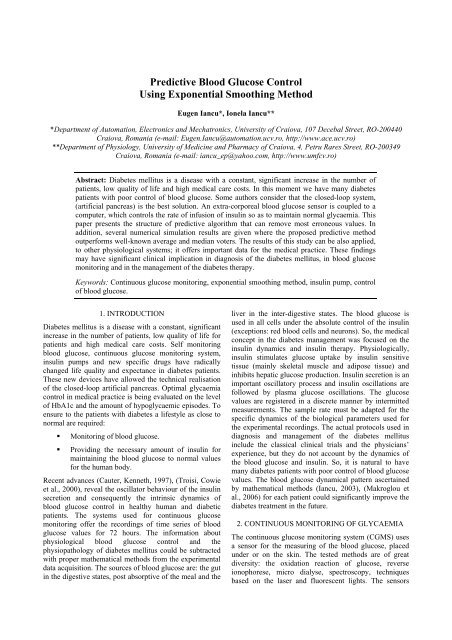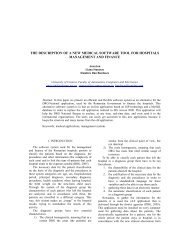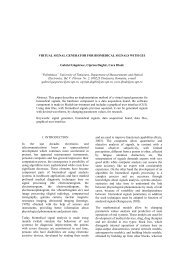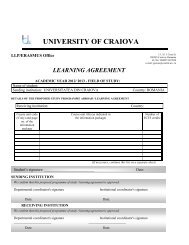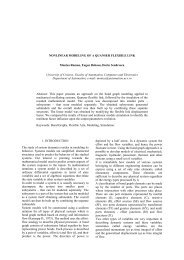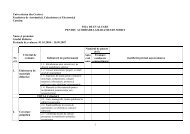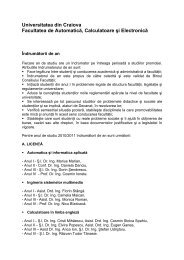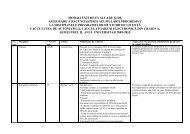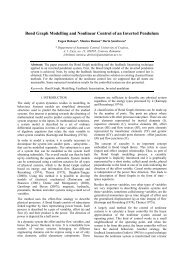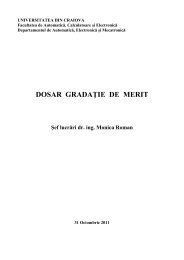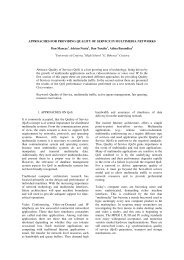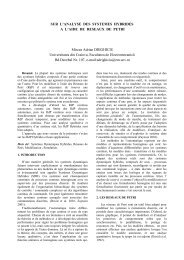Predictive Blood Glucose Control Using Exponential Smoothing ...
Predictive Blood Glucose Control Using Exponential Smoothing ...
Predictive Blood Glucose Control Using Exponential Smoothing ...
Create successful ePaper yourself
Turn your PDF publications into a flip-book with our unique Google optimized e-Paper software.
<strong>Predictive</strong> <strong>Blood</strong> <strong>Glucose</strong> <strong>Control</strong><strong>Using</strong> <strong>Exponential</strong> <strong>Smoothing</strong> MethodEugen Iancu*, Ionela Iancu***Department of Automation, Electronics and Mechatronics, University of Craiova, 107 Decebal Street, RO-200440Craiova, Romania (e-mail: Eugen.Iancu@automation.ucv.ro, http://www.ace.ucv.ro)**Department of Physiology, University of Medicine and Pharmacy of Craiova, 4, Petru Rares Street, RO-200349Craiova, Romania (e-mail: iancu_ep@yahoo.com, http://www.umfcv.ro)Abstract: Diabetes mellitus is a disease with a constant, significant increase in the number ofpatients, low quality of life and high medical care costs. In this moment we have many diabetespatients with poor control of blood glucose. Some authors consider that the closed-loop system,(artificial pancreas) is the best solution. An extra-corporeal blood glucose sensor is coupled to acomputer, which controls the rate of infusion of insulin so as to maintain normal glycaemia. Thispaper presents the structure of predictive algorithm that can remove most erroneous values. Inaddition, several numerical simulation results are given where the proposed predictive methodoutperforms well-known average and median voters. The results of this study can be also applied,to other physiological systems; it offers important data for the medical practice. These findingsmay have significant clinical implication in diagnosis of the diabetes mellitus, in blood glucosemonitoring and in the management of the diabetes therapy.Keywords: Continuous glucose monitoring, exponential smoothing method, insulin pump, controlof blood glucose.1. INTRODUCTIONDiabetes mellitus is a disease with a constant, significantincrease in the number of patients, low quality of life forpatients and high medical care costs. Self monitoringblood glucose, continuous glucose monitoring system,insulin pumps and new specific drugs have radicallychanged life quality and expectance in diabetes patients.These new devices have allowed the technical realisationof the closed-loop artificial pancreas. Optimal glycaemiacontrol in medical practice is being evaluated on the levelof HbA1c and the amount of hypoglycaemic episodes. Toensure to the patients with diabetes a lifestyle as close tonormal are required:• Monitoring of blood glucose.• Providing the necessary amount of insulin formaintaining the blood glucose to normal valuesfor the human body.Recent advances (Cauter, Kenneth, 1997), (Troisi, Cowieet al., 2000), reveal the oscillator behaviour of the insulinsecretion and consequently the intrinsic dynamics ofblood glucose control in healthy human and diabeticpatients. The systems used for continuous glucosemonitoring offer the recordings of time series of bloodglucose values for 72 hours. The information aboutphysiological blood glucose control and thephysiopathology of diabetes mellitus could be subtractedwith proper mathematical methods from the experimentaldata acquisition. The sources of blood glucose are: the gutin the digestive states, post absorptive of the meal and theliver in the inter-digestive states. The blood glucose isused in all cells under the absolute control of the insulin(exceptions: red blood cells and neurons). So, the medicalconcept in the diabetes management was focused on theinsulin dynamics and insulin therapy. Physiologically,insulin stimulates glucose uptake by insulin sensitivetissue (mainly skeletal muscle and adipose tissue) andinhibits hepatic glucose production. Insulin secretion is animportant oscillatory process and insulin oscillations arefollowed by plasma glucose oscillations. The glucosevalues are registered in a discrete manner by intermittedmeasurements. The sample rate must be adapted for thespecific dynamics of the biological parameters used forthe experimental recordings. The actual protocols used indiagnosis and management of the diabetes mellitusinclude the classical clinical trials and the physicians’experience, but they do not account by the dynamics ofthe blood glucose and insulin. So, it is natural to havemany diabetes patients with poor control of blood glucosevalues. The blood glucose dynamical pattern ascertainedby mathematical methods (Iancu, 2003), (Makroglou etal., 2006) for each patient could significantly improve thediabetes treatment in the future.2. CONTINUOUS MONITORING OF GLYCAEMIAThe continuous glucose monitoring system (CGMS) usesa sensor for the measuring of the blood glucose, placedunder or on the skin. The tested methods are of greatdiversity: the oxidation reaction of glucose, reverseionophorese, micro dialyse, spectroscopy, techniquesbased on the laser and fluorescent lights. The sensors
nocturnal hypoglycaemic risks. Furthermore, theunexpected and irregular oscillations of glycaemia havebeen constantly observed in the blood glucose dynamic atdiabetes patients. The limits of the insulin pump consistedin the medical point of view in possible complications(infections, detachments or false readings) and thenecessity of replacement at relative small periods. Fromthe precision point of view, a high dispersion ofmeasurements has been seen. For every administrationway there is an absorption curve specific for insulin, timeconstants and action periods that impose theparticularisation of the glycaemia control algorithms.5. CONTROL OF BLOOD GLUCOSEMonitoring systems have revealed rapid changes inglycaemia, which requires a sophisticated controlstructure. The generalised structure of the control systemfor blood glucose is shown in the Figure 4.ActuatorInsulininfusionpump<strong>Control</strong>lerDisturbances:(estimated values)• Food intake• Physical activityPatient<strong>Glucose</strong>(measured values)Management of decisionsPatient modelFig. 4. The structure of the predictive system for bloodglucose control (Iancu, 2010).ProcessmeasurementsProcess<strong>Glucose</strong>sensorThe control system for blood glucose must faceperturbations.<strong>Using</strong> the predictive control theory we can minimizedeviations of blood glucose from normal levels, whilepenalizing the use of large amounts of infused insulin forsafety.The insulin infusion pump allows a constant andpredictable delivery rate of insulin into a subcutaneoussite. The efficiency of the predictive control system is tokeep the blood glucose levels as close to normal aspossible. This behaviour is essential for preventingdiabetes related complications. Ideally this level isbetween 60 and 120 mg/dl before meals and less than 180mg/dl two hours after starting a meal.The more popular scheme for control processes affectedby time delay was proposed by O. J. M. Smith (Smith,1959). This algorithm requires a minimal knowledge ofthe process to describe it through a transfer function(model):P−sτ( s) G( s) e= (1)Unfortunately, the knowing of the mathematical modelattached to the patient is a difficult problem. <strong>Using</strong> Smithpredictors leads to good results in controlling bloodglucose concentration. These results can be severelyaffected by the errors of estimation of model parametersand especially by the incorrect determination of deadtime. This can lead to instability of control system, withserious consequences for the patient's life.Given this situation, the authors propose to use analgorithm based on exponential smoothing (Fig. 6). In thisway we can get in real-time feedback information fromthe patient, which can be used by the controller tosynthesis the commands for the insulin pump.The complex and highly non-stationary nature(Kovatchev, Clarke et al., 2005), (Zick, Petersen et al.,2007) of the blood glucose time series, especially indiabetic patients and the permanent influence of theexternal perturbations (meal, sleep, exercise, othertreatments etc.) require a complex series of mathematicalstudy methods.InsulininfusionpumpPatient<strong>Glucose</strong>sensor<strong>Predictive</strong>algorithmFuture processoutputsObjectivesConstraintsOptimization problemBest currentandfuture commands<strong>Control</strong>ler<strong>Glucose</strong>(estimated values)<strong>Glucose</strong>(measured values)<strong>Exponential</strong> smoothing processingFig. 5. The structure for the predictive control system.Fig. 6. The structure of control system with exponentialsmoothing.
However, statistical methods have the advantage to beaccurate and robust, simple enough to be implementedwith low costs.6. EXPONENTIAL SMOOTHING METHODSingle exponential smoothing is used for smoothingdiscrete time series. The efficiency of this algorithm canbe attributed to its simplicity and to the capacity to adjustits responsiveness to changes in the process and itsreasonable accuracy.Let be an observed time series X { x x ... }= 1 2 x n .Formally, the simple exponential smoothing equationtakes the form (Ostertagová, 2011):~ xix~1 = α i + (1 − α ) xi+ (2)where x i is the actual, known series value at momenttime i,~xiis the forecast value of the variable X at time i,~x i+1is the forecast value at time i+1 and α is thesmoothing constant.<strong>Smoothing</strong> constant α is a selected number between zeroand one, 0
StatisticparametersMean of blood glucosevalues - μ (mg/dl)Table 1. Statistic parametersPatient P1(injections)Patient P2(pump)Healthysubject199.31 101.28 86.56Standard deviation - σ 81.02 17.29 6.14Confidence Minimum 189.91 99.27 85.85interval forMaximum 208.71 103.28 87.2795%Confidence Minimum 186.93 98.63 85.62interval forMaximum99%211.69 103.92 87.508. CONCLUSIONSClinical studies have shown a high correlation betweenglucose variability and chronic complications of diabetes.Glycaemia variability has also indicated, along thestudies, unsatisfactory treatment and management of thedisease.In medical practice, the mean glucose was accepted as theonly significant and relevant measure of glycaemiavariability. Despite these, predictive control of the closedloop control system, based on a mathematical model, isdifficult to accomplish because these oscillations have anunknown and unpredictable source.<strong>Blood</strong>glucose concentration [mg/dl]400350300250200150actual valuesforecast:0.2forecast:0.6forecast:0.9100500 50 100 150 200 250 300Time in samplesFig. 8. The result of single exponential smoothing for a record from P2 patient, with insulin pump.<strong>Blood</strong> glucose concentration [mg/dl]400350300250200150actual valuesforecast:0.2forecast:0.6forecast:0.9100500 50 100 150 200 250 300Timein samplesFig. 9. The result of single exponential smoothing for a record from the healthy subject.
It can be seen the efficiency of this algorithm. The singleexponential smoothing for blood glucose records can beused in predictive control because it offers in real time theforecast values, it is easy to use and affordable, it has thecapacity to adjust its responsiveness to changes in theprocess and has reasonable accuracy.REFERENCESBrown, R. G., Meyer, R. F. (1961), The fundamentaltheory of exponential smoothing, OperationsResearch, 9, pp. 673-685.Iancu, Ionela, E. Iancu, Modeling and Simulation inPhysiology, (2003) Ed. Universitaria Craiova, pp.146-158, ISBN 973-8043-406-5.Iancu E., Ionela Iancu, Maria Mota (2008) Statisticalanalysis of the blood glucose data for automateddiagnosis, International Conference on Mathematics &Computers in Biology & Chemistry (MCBC’08),Bucuresti, România, Proceedings of the conferenceISBN 978-960-6766-75-6, pp. 17-21.Iancu Ionela, Maria Mota, E. Iancu, (2008) Method forthe analysing of blood glucose dynamics in diabetesmellitus patients, The 2008 IEEE InternationalConference on Automation, Quality and Testing,Robotics – AQTR 2008, THETA 16, Cluj-Napoca,România, Proceedings of the conference, IEEECatalog number: CFP08AQT-PRT, ISBN: 978-1-4244-2576-1, vol.3, pp. 60-65.Iancu Ionela, Maria Mota, E. Iancu (2010) Computerassistedmonitoring and diagnosis in patients withdiabetes. Contributions to the development ofautomated systems for blood glucose control, Ed.SITECH, ISBN 978-606-11-0743-8.Kovatchev, Boris P., William L. Clarke, Marc Breton, K.Brayman, A. McCall, (2005), Quantifying Temporal<strong>Glucose</strong> Variability in Diabetes via Continuous<strong>Glucose</strong> Monitoring: Mathematical Methods andClinical Application, Diabetes Technology &Therapeutics ;7 (6), pp.849-862.Makroglou, Athena, Jiaxu Li, Yang Kuang, (2006)Mathematical models and software tools for theglucose-insulin regulatory system and diabetes: anoverview, Applied Numerical Mathematics 56 pp.559–573, www.elsevier.com/locate/Ostertagová, E., Oskar Ostertag (2011) The simpleexponential smoothing model, The 4 th InternationalConference on Modelling of Mechanical andMechatronic Systems, Technical University of Košice,Slovak Republic, Proceedings of conference, pp. 380-384.Smith, O. J. , (1959) A controller to overcame dead time,ISA Journal, Vol. 6, No.2, pp.28-33.Troisi J. Rebecca., Catherine C. Cowie, Maureen I.Harris, (2000) Diurnal variation in fasting plasmaglucose, JAMA, 284, pp.3157-3159.Van Cauter, Eve, Kenneth S. Polonsky, André J. Scheen,(1997) Roles of circadian rhythmicity and sleep inhuman glucose regulation, Endocrine Reviews 18 (5):pp. 716-738.Zick, Reinhard, Bettina Petersen, Mario Richter, CorneliaHaug, (2007) Comparison of Continuous <strong>Blood</strong><strong>Glucose</strong> Measurement with ConventionalDocumentation of Hypoglycemia in Patients withType 2 Diabetes on Multiple Daily Insulin InjectionTherapy, Diabetes Technology & Therapeutics, 9(6),pp. 483-492.


